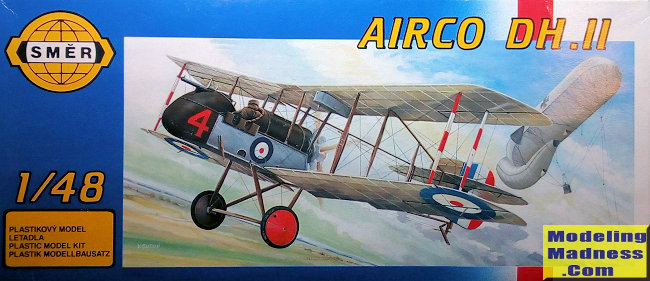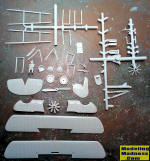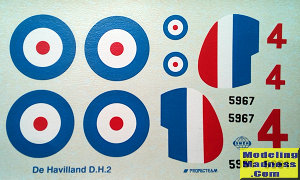
SMER 1/48 DH.2
| KIT #: | 0806 |
| PRICE: | €5.00 |
| DECALS: | Two options |
| REVIEWER: | Spiros Pendedekas |
| NOTES: | Kit is actually 1/50 |

| HISTORY |
The Airco DH.2 was a
single-seat pusher biplane fighter aircraft which operated during the First
World War. It was the second pusher design by aeronautical engineer Geoffrey de
Havilland for Airco, based on his earlier DH.1 two-seater.
The development of pusher configuration fighters, such as the DH.2 and the
F.E.2b enabled forward firing armament before the development of synchronization
gears such as that fitted to the Fokker Eindecker. The prototype DH.2 made its
first flight in July 1915, but it was lost during the following month, on its
service trials on the Western Front.
Production DH.2s were introduced to frontline service in February 1916 and
became the first effectively armed British single-seat fighter. It enabled Royal
Flying Corps (RFC) pilots to counter the "Fokker Scourge" that had given the
Germans the advantage during late 1915. It served in fighting and escort duties
for almost two years, while numerous pilots became flying aces using the type.
As it was progressively outclassed by newer German fighters, it was eventually
withdrawn from first line service in France after RFC units completed the
process of re-equipping with newer fighters, such as the Nieuport 17 and Airco
DH.5, in June 1917.
| THE KIT |
 This
kit was first issued by Merit back in the 50’s, then reboxed by Artiplast
sometime in the 70s, followed by three SMER reissues, the last of them (which is
the subject of this preview), taking place in the early 2000s with better
decals. It comes in a good quality one piece glued tuck-top box, with a very
attractive box art of a DH2 having just passed by a German zeppelin.
This
kit was first issued by Merit back in the 50’s, then reboxed by Artiplast
sometime in the 70s, followed by three SMER reissues, the last of them (which is
the subject of this preview), taking place in the early 2000s with better
decals. It comes in a good quality one piece glued tuck-top box, with a very
attractive box art of a DH2 having just passed by a German zeppelin.
Upon opening the box, I was greeted with 42 light gray styrene pieces, arranged
in three sprues and sealed in a bag, with a number of them already detached from
the sprue trees (mostly due to yours truly mishandling). Upon examining the
contents, the ancient origins of the kit were more than evident with thick sprue
gates and a lot of flash, with the markings already molded onto the surfaces!
Needless to say that whatever detail is of the raised type.
There is some sort of cockpit to speak of, including a floor, instrument panel
with a few molded on instruments, stick, rudder pedals, rear bulkhead, seat and
the machine gun, but all are very simplistic looking. No color callouts are
provided, but, thankfully, we live in the Net days, so it will not be very
difficult to sort yourself out. A mummy pilot is also provided.
The distinctive struts, a key feature of the DH.2, are averagely represented.
Wings, tail planes and fin are all single piece affairs, with acceptable fabric
representation but numerous prominent ejector pin marks that will have to be
filled and sanded smooth (together with the “50s feature” molded on markings).
The fuselage halves have some adequate representation of the stitched surface
detail (DH.2s had wooden nose and upper deck, the rest of the fuselage covered
with fabric with prominent stitches at the borders). Luckily, the molded-on
roundels do not interfere with the stitched details
The exposed engine, another key feature of the DH.2, is also simplistic looking.
The landing gear looks sufficient with the wheel covers provided separately and
featuring some raised detail, but not the distinctive hole that was found near
their circumference (quite easily done by micro-drilling, though). Finally, the
port-mounted fuel tank under the top wing, the rudder activating levers located
bilaterally of the cockpit and four ammo magazines are also provided, looking
also simplistic.
Instructions come in the form of a folded A3 size paper, containing a nice
history of the type, with the simple construction spread in 6 clear steps with
logical sequence. Two RFC markings options are provided: one with an overall
green fuselage and green wing topsides and another more colorful with green/gray
fuselage, all-“linen” wings, red wheel covers and red/white outer interplane
struts. The latter scheme is depicted in color at the kit box undersides – a
nice touch. Colors are provided in generic names and also in Humbrol codes.
 Decals are
printed by Propacteam and look perfectly registered but overly thin: I have used
them in the past and, while providing excellent results if handled with extreme
care, they are intolerant to the slightest mishandling.
Decals are
printed by Propacteam and look perfectly registered but overly thin: I have used
them in the past and, while providing excellent results if handled with extreme
care, they are intolerant to the slightest mishandling.
Instructions first want you to assemble the minimalistic cockpit and trap it
between the fuselage halves, together with the machine gun and engine supporting
shaft. Then the engine has to be assembled and installed. The fuselage is then
attached to the lower wing, together with all interplane struts. The fuel tank
is next attached under the top wing, with the whole assembly affixed onto the
interplane struts, followed by the two piece distinctive rear frame, the tail
plane, fin and tail skid. Final step includes assembly and attachment of the
main landing gear, ammo magazines and rudder activating arms.
Though construction seems simple and un-complex, it does not necessarily mean
that it is not complicated: indeed, the opposite has good chances to be true,
due to the crudity of the parts and the many struts that have to be aligned, to
name a few (and, of course, the extensive rigging required, a prominent feature
of the DH.2).
| CONCLUSIONS |
Eduard presented
their 1/48 DH.2 in 2005, regularly reissuing it ever since (including a very
interesting “strip down” version among them) at very sensible prices. Though
among their earlier offerings, this is everything we have come to expect from
Eduard, with the completed models shining, as Tom Cleaver demonstrated here.
BlueMax back in the 90s offered a difficult but also accurate
quarter scale DH.2. This kit is very difficult to find nowadays (and, honestly,
there is little point in preferring it over the “mainstream” Eduard)
The SMER rebox is a
simplistic, ancient tooling kit of this important and distinctive looking WWI
fighter. Parts look crude, markings are molded onto the surfaces and general
detailing is barely average. Parts count is low, but it is not expected to be an
easy build, especially if you want to come up with a passable representation of
the real plane. It can still be found nowadays, typically offered at low prices,
which kind of makes sense. Should you wish to tackle it, you are expected to put
in a lot of extra effort, in order to come up with a good result.
Happy modeling!
February 2022 Copyright ModelingMadness.com.
All rights reserved. No reproduction in part or in whole without express
permission. If you would like your product reviewed fairly and
fairly quickly, please
contact
the editor or see other details in the
Note to
Contributors.